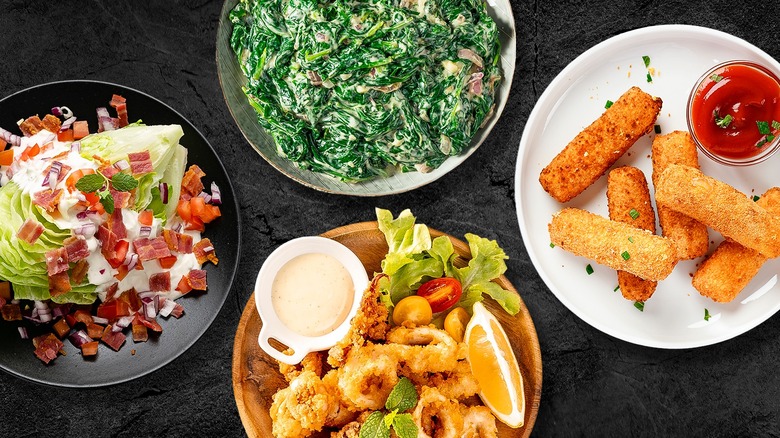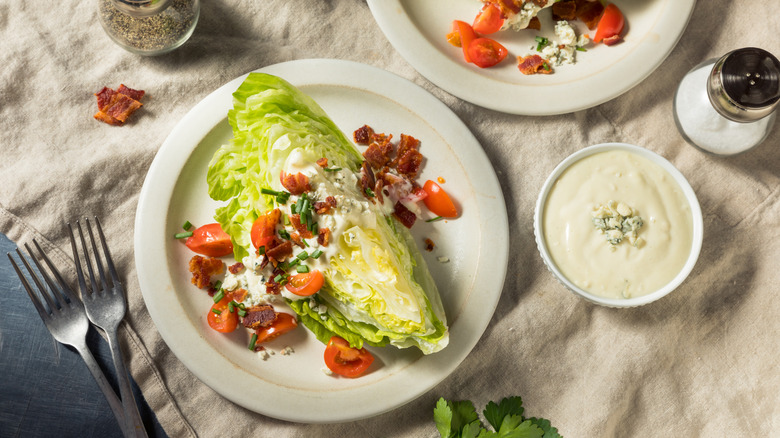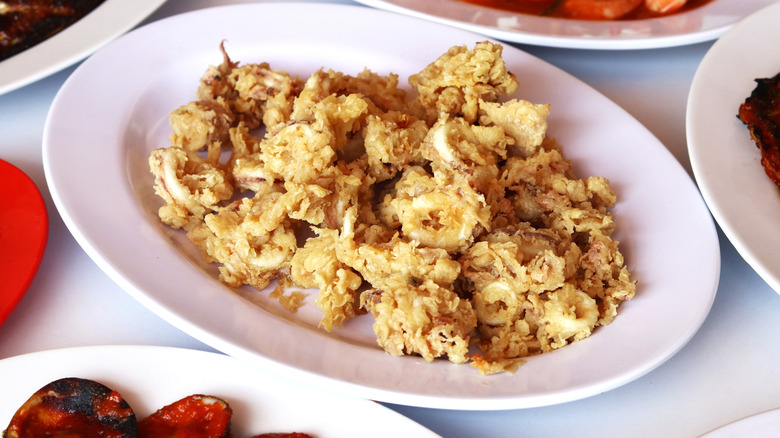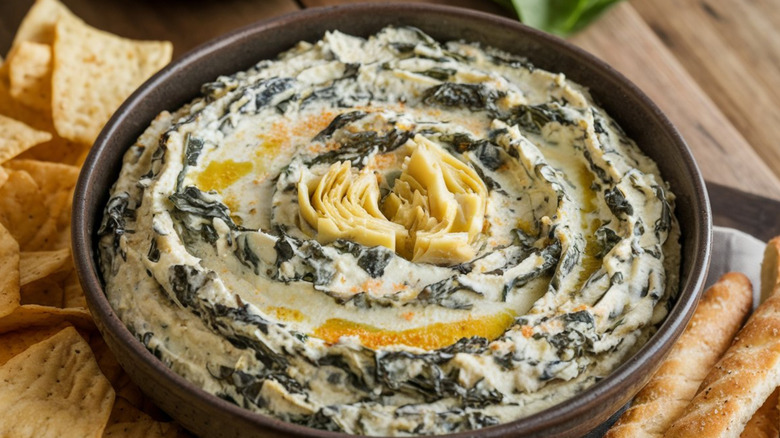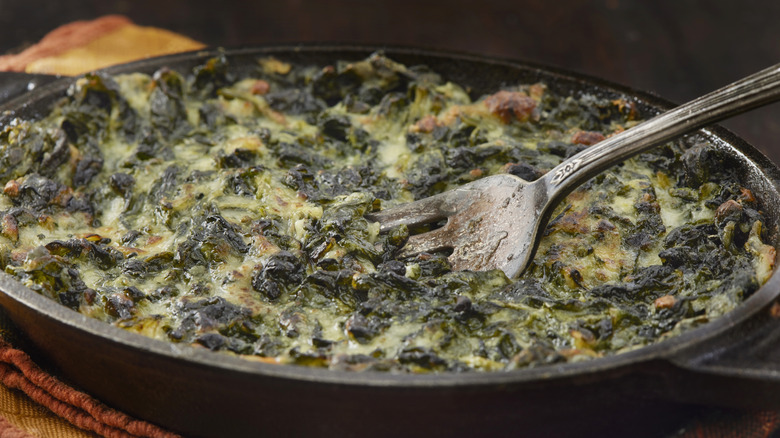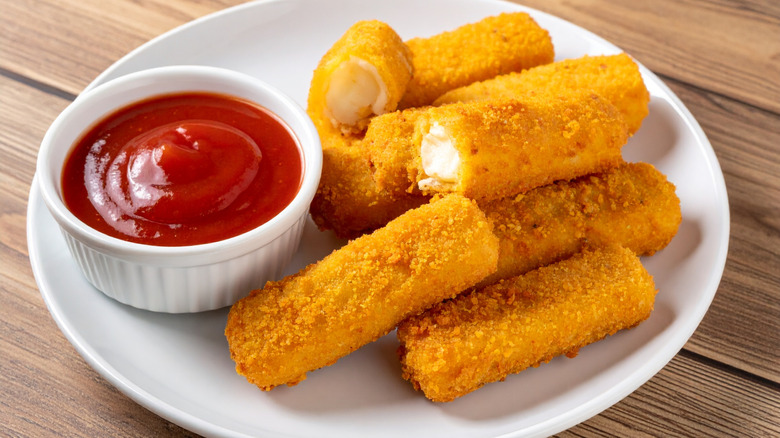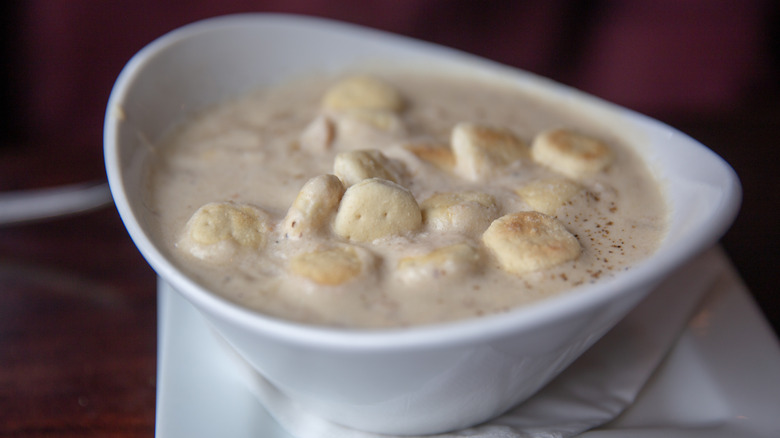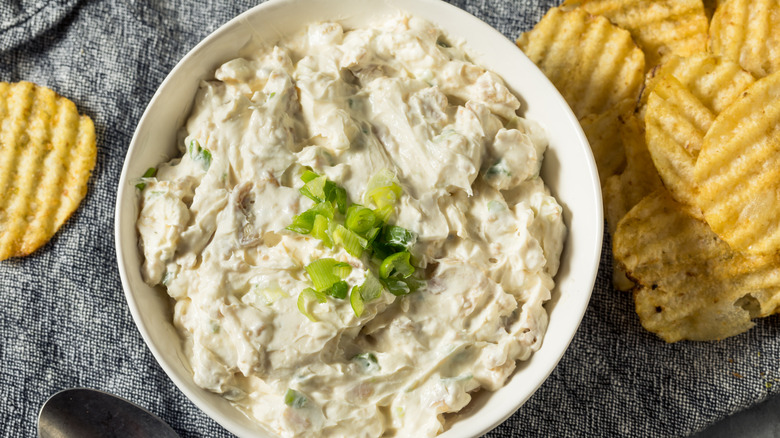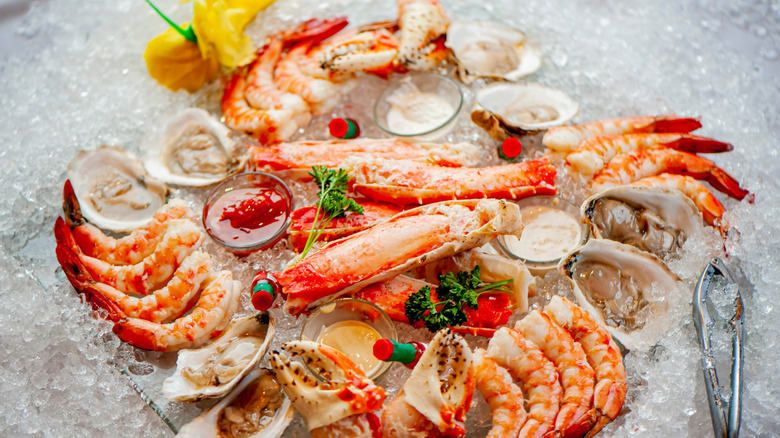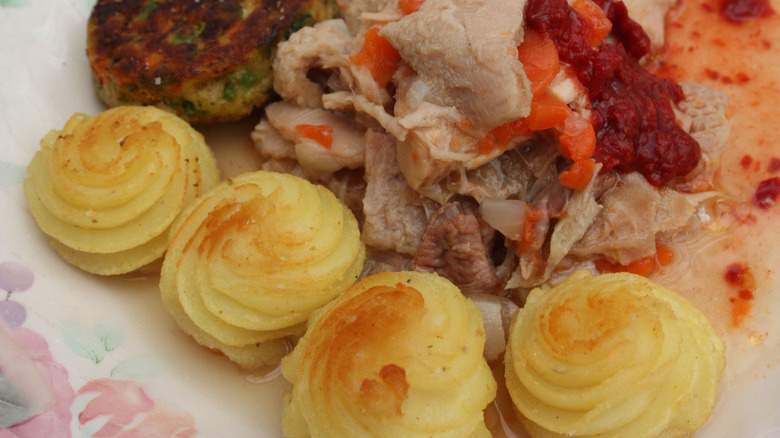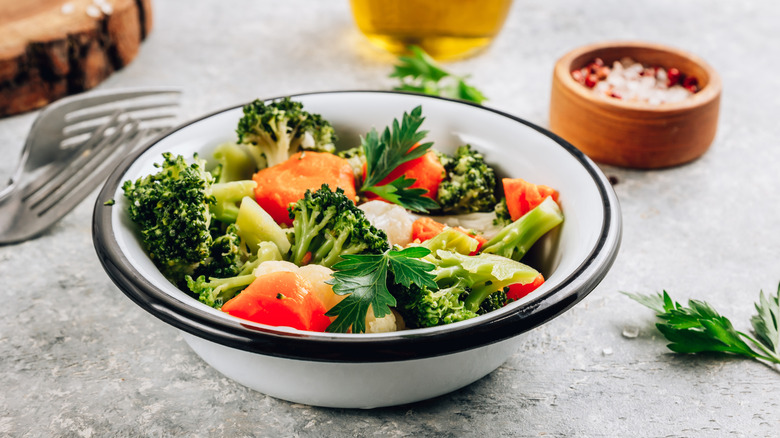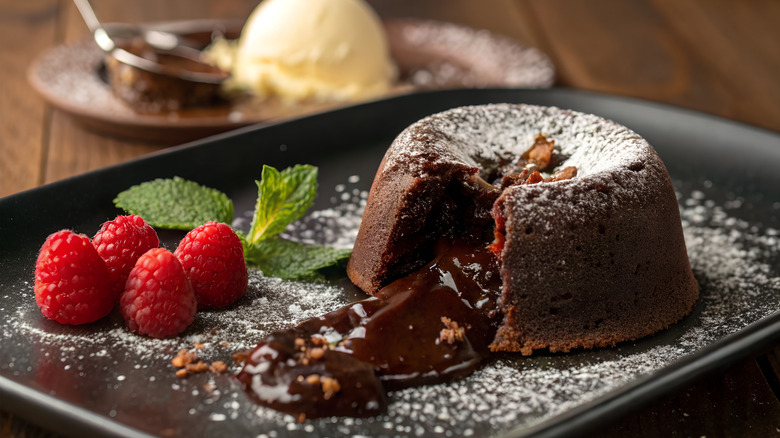Popular Steakhouse Menu Items That Desperately Need A Refresh
With red leatherette booths, campy hunting-themed decor, and Rat Pack cocktails, the always-enduring American steakhouse is a culinary time capsule, frozen in place with midcentury culinary baggage. Many menus still echo Depression-era hardships and wartime food rationing, continuing a dubious tradition of cheap, ultra-processed ingredients used during the 1930s and extended into the convenience era of the 1960s.
Many steakhouses still serve safe, bland side dish recipes that are eight decades old, and wonder why they're losing younger clientele, families with young kids, and more adventurous older diners. A few of these standard favorites might be resuscitated with superior ingredients, but most are a huge snooze and need to be deep-sixed altogether.
To update means to upgrade and prove that comfort food can be exciting. Today's discerning diner demands a higher-quality eating experience, with an emphasis on fresh, local, seasonal ingredients, appreciation of rustic food treatments, and a more adventurous, global attitude. The key is to awaken and surprise the eye and palate with contrasts in flavor, texture, and plating to offset the heavy, glossy richness of beef. Here are some popular steakhouse menu items long overdue for an upgrade.
Parker House rolls
This Boston-born starter is usually the definition of inexpensive, soulless "white bread." And some chefs (including the late, great Anthony Bourdain) warned against "house bread" which may be served, handled, and reheated multiple times. As with all restaurant menu items, dedication to quality is the bedrock of a great meal. But hear this: A great piece of warm, absorbent bread, like the sultry neon-orange garlic cheese loaf that Burbank's Smoke House has served since 1946, is recommended for those who whet their appetites at the bar long before picking up a knife and fork for the main course.
The Parker House roll's traditional folded-over plumpness, however, is uniquely appetizing, and James Beard encouraged experimenting with the shape. The quality of this roll may have declined since its 19th century beginnings in Bean Town, so adding mashed sweet potato and maple syrup into the dough is one idea for restoring this sweet, all-American classic to its deserved place on the table.
Wedge salad
This doorstop-like side is almost impossible to eat gracefully because of its unwieldy height, and iceberg lettuce is now widely considered retro, even a bit boring. Like many steakhouse sides, the iceberg lettuce used for the wedge salad reflects its origin story. Unlike thinner, more easily bruised lettuce varieties like arugula, endive, and radicchio, the dense, tightly furled leaves and high water content of iceberg made it ideal for transporting long distances. By the 1950s, iceberg was the most popular lettuce in the U.S., and the firm, sturdy heads were shipped out as military rations to U.S. troops in Vietnam.
The tall, triangular block of colossal roughage requires being toppled with a knife and fork to dig in, inevitably sending its crown of blue cheese crumbles and bacon bits flying. A more sophisticated take on this side's good points — crisp, cool garden textures, a tang of fermentation — could take the form of a chopped fennel-jicama salad with crunchy slivers of peeled, diced pear and apple, sliced red onion for zing, and a few dried cherries for deep, chewy sweetness, all enlivened with a splash of cider vinegar.
Fried calamari
These heavily breaded straps of doom qualify as the rubber bands of the deep, unless fresh local squid is used — otherwise, it could be one of the worst appetizers on the menu. If you're not dining while overlooking Monterey Bay, where squid jiggers share the waves with surfboard-snatching sea otters, this is unlikely. The majority of U.S.-caught squid is exported to Asia. Typically frozen, squid are a prime example of how changing times present opportunities to re-imagine our food choices.
Squid is best when wild-caught close to where you'll eat it, not only for sustainability but also for quality, since Asian-sourced squid is usually double-frozen, destroying the delicate texture of the flesh (see: the secret life of rubber bands). Ethically farmed shrimp with third-party sustainability certification, flash-fried in a thin tempura batter, may be a more tender, upscale alternative. In addition to issues with the origin of the squid, American steakhouse prep often is not well-informed regarding this protein. Ideally, chefs cook squid to order in a few minutes.
In order to prep and serve this way, squid can't linger on the steam table or under heat lamps, which tighten its muscles. The alternative is slow-cooking over 30-45 minutes, which allows the squid's collagen to melt down into a gelatin — but are you willing to wait that long for your app? The answer's usually "no," explaining the rubbery rep of this side dish and appetizer.
Artichoke dip
Maybe this side was a good idea once upon a time, but today a pot of this warm, sticky wallpaper paste is a dip that's often recall-prone and long past its cultural expiration date. Like many a tuckered-out steakhouse standard, most artichoke dip is as heavy and fatty as the meaty main course, creating an inelegant redundancy. Also, since artichokes are seasonal (and most flavorful in spring), if you hit the calendar at the wrong time, your artichoke dip will likely be made from canned 'chokes, which aren't terrible but also aren't at their earthy best. And it goes without saying that the spinach will likely be frozen.
Grilled whole artichokes are the obvious alternative, but some diners may object to the messy pulling apart and picking at the leathery petals required, especially during a business dinner or date night. Roasted, charred artichoke hearts served with warm marinara sauce or even just lemon-garlic butter are tidier. Eating artichokes prepared this way, where the artichoke itself is the star without fillers like cream cheese, captures more of the floral essence of what is in fact an unopened flower bud. To simply elevate the chip-and-dip moment, replace bulk and boredom with hot-sweet habanero and mango guacamole splashed with fresh lime juice for a sharp, interesting twist.
Creamed spinach
Perfect after a root canal, when you can't chew and really don't want to eat, creamed spinach seems out of touch with our health-conscious, authenticity-seeking times. Circa the late 1940s in postwar hot spots like San Francisco's House of Prime Rib and the Blackhawk in Chicago, this homogeneous, soft side must have seemed posh, since all of the ingredients are so utterly integrated that they bear no memory of soil, sun, human sweat, weather, or the brutal natural world. Clarence Birdseye's innovations in freezing foods opened up new possibilities for American chefs in the 1930s and 1940s, when canned goods became scarce and butter and cream were rationed. By the 1950s, the heavy cream and butter components of this dish, along with the convenience of frozen spinach, epitomized post-war optimism.
Perhaps in an attempt to emulate sophisticated European cookery, ingredients were minced finely and often surrendered their character as a result. Today, rather than disguising food origins, a contemporary plate celebrates the stories ingredients tell, presented with style.
Beef, pork, game, and lamb are rich enough on their own and don't need to be bolstered by creamy dishes. A welcome contrast: Crisp-tender blanched green beans, wrapped with thin-cut bacon and glazed with soy sauce, butter, and dark brown sugar, are a robust yet polished accompaniment to a filet, steak, or chop. Or, especially when dining with a group, a plate of individual mini-spanakopita — bites of spinach and feta sealed in hot, light-as-air filo. Opa!
Fried mozzarella sticks
Mozzarella sticks are country fair-worthy, right next to the deep-fried Twinkies they resemble. There's no arguing about the appeal of fried foods. They've become progressively more irresistible in recent decades as the result of food engineering, the rather diabolical process by which foods become "hyperpalatable," even comparable to narcotics by some nutrition experts. Teams of technicians devote themselves to designing processed foods with specific fat-salt-acid-sweet-crispy-melty ratios of flavor, texture, mouthfeel, and even sound that stimulate the brain's reward system, making us crave more and more. These powerful neural signals override the body's natural satiety point that says "I'm good, thanks."
No virtue-signaling here, but fried mozzies, admittedly tempting when paired with an array of sauces, now seem more like bowling alley bar snacks versus a side for prime protein in a white-tablecloth setting. A more refined but still blissfully gooey swap might be cauliflower gratin, bubbling over with a golden-baked breadcrumb topping to approximate that coveted crunchy, fry-basket finish.
Boston clam chowder
Please. Unless you can hear, see and smell the breaking surf from your table, promising the sea-breeze freshness of local bivalves, skip this typically leaden starter stretched with bulky potato cubes that most restaurants purchase pre-made from a high-sodium, canned soup base that's usually less than healthy.
The Bay State of Massachusetts claims Ye Olde Union Oyster House as America's oldest restaurant and the home of the white, cream-based fish stew. Other parts of New England, like Rhode Island, assert bragging rights for their own interpretations, and all self-respecting Yanks seem to disparage the red, tomato-based Manhattan clam chowder on principle.
It is likely that in 1836, more abundant coastal seafood made potatoes unnecessary to the recipe. As with other seafood dishes now facing changing oceans, if the catch of the day was swimming offshore yesterday, this chowder will be superb. If not, a lighter and brighter soup better piques the modern appetite without being too filling. Pureed carrot soup with coriander, fragrant with ground cumin and sharp spices, calls taste buds to attention in preparation for a rich entree.
Clam dip
It is a fact that our tastes change with the times. Atomic-age bullet bras and pillbox hats now seem like wardrobe pieces from another planet, and this terribly outdated side dish also belongs firmly in the past.
Clams in general elicit shudders of revulsion from many diners who aren't familiar with steamers, cherrystones, littlenecks, or the mighty (and mighty weird) geoduck. This cocktail party staple of the Cold War era was made with canned, condensed clam soup, disguising the minced clams themselves in a neutral, non-threatening, only faintly marine paste. Today, the super-salted, briny taste of canned clams used in this old-school dip lacks the authenticity that modern foodies hunger for.
Steakhouse side upgrades call for swapping canned ingredients with fresh. For a hearty starter with a dippy texture, lending itself to sociable sharing and passing, a zesty buffalo wing blend combines shreds of freshly roasted, savory, moist chicken with blue cheese or ranch dressing and freshly grated Colby-Monterey Jack. It's ideal served with blue corn tortilla scoops, chilled cucumber slices, and crisp, cold celery and carrot sticks.
Seafood tower
This ostentatious side, which usually arrives spewing a dry-ice cloud big enough for a KISS concert, is more about glamour than gourmet gastronomy in spite of the sure-to-be lofty price tag. And, its sheer scale is an embarrassment, along the lines of that gas-guzzling eight-cylinder behemoth that your Nana refuses to surrender. This T-Rex of the steakhouse also has other problems. Changes in the marketplace and on the planet now make this showy presentation impractical. Global warming, overfishing, rising fuel prices, labor shortages, and supply chain snags have continually driven a rise in seafood prices over the past few years. What might you start to see instead? Surprisingly enough, hot dogs now may appear as an Instagram-ready surf-to-turf replacement in some cost-cutting towers.
As with all sea proteins, fresh-caught is the pristine gold standard that's almost unattainable today. Embracing the reality that most seafood will be frozen, a "less is more" approach concentrates on what's good. A dozen pricey but succulent snow crab cocktail claws with three sauces — chimichurri, curry mustard with wasabi, and dill mayo — offer a luxurious, more stylish alternative.
Duchess potatoes
Potato puffs should be a hard pass for steakhouse diners, although this weary vintage side may merit a comeback when made at home from scratch using top-shelf ingredients. This dish may be another instance of American cooks trying for continental flair several decades ago. Because making duchess potatoes requires several additional steps beyond peeling and boiling, this decorative side needs to be made far in advance for dinner service in a typical restaurant setting. In fact, the piped rosettes may be moved into the fridge for an indeterminate period, the first step in the descent into inedibility, before they're reheated and brought to your table.
In search of an equally coquettish substitute starch, sweet potato orange cups are a festive, fresh, comfort-food side with just enough tartness to awaken the tongue. The roasted tuber can be fork-mashed, then spooned into a zesty citrus half, topped with dried cranberries and pecan halves. Especially appealing for fall and winter holiday meals, this sunny side's burst of slight acidity is invigorating when navigating a plush, juicy beef main.
Broccoli florets and carrot coins
So many steakhouses just plop a big ol' scoop of these steam-table veggies beside a piece of prime beef, lacking imagination and culinary courage. Right out of the freezer, generally in huge, tough, uncouth hunks and served unseasoned, austere sides like this are the reason many people haven't yet discovered the best ways to prepare vegetables. Even those of us who love our root veggies and cruciferous greens push these plain, unloved veggie sides to the edge of the plate when dining out, flashing back on those dreary school cafeteria lunches of another lifetime.
A vegetable side to beef needs to be anything but bland. Something with umami, sharp, sour, and even bitter notes provides the necessary contrast to rich, fatty meat. A broccoli relative, namely the radish, may be the surprising solution. Spicy when served raw, radishes are subtly savory when roasted with olive oil and rosemary. Moreover, radishes have been revered by Chinese and South Asian medicine traditions for millennia for their ability to detox the liver — a nice tidbit of knowledge when indulging in copious amounts of red meat and wine.
Chocolate lava cake
There was a hedonistic time when this gooey-centered confection seemed outrageously daring for its unapologetic excess, just like a mousse-hardened mullet (the Joe Dirt 'do, not the fish) once seemed super hip. Today, chocolate lava cake no longer registers as "decadent." In fact, after a big steak feed, it reads both on the palate and belly as simply too much, too late, and better suited to a frantic tween Swiftie squealfest than a grown-up dining experience.
And yet, even though we're stuffed to the gills, we scarf it down, although we've consumed enough calories in a single sitting to power the Dodgers through the World Series. In this way, chocolate will always trigger the kid in every diner, so a cacao-rich dessert persists as a must. The unlikely addition of crushed, canned black beans to a pan of brownies adds surprising depth of flavor, as well as a fiber flex that may be welcome after downing a feast fit for Henry VIII. Top the black bean brownies with the refreshing shock of pink peppercorn-and-spicy-saké ice cream, and this sweet ending is anything but stodgy.
